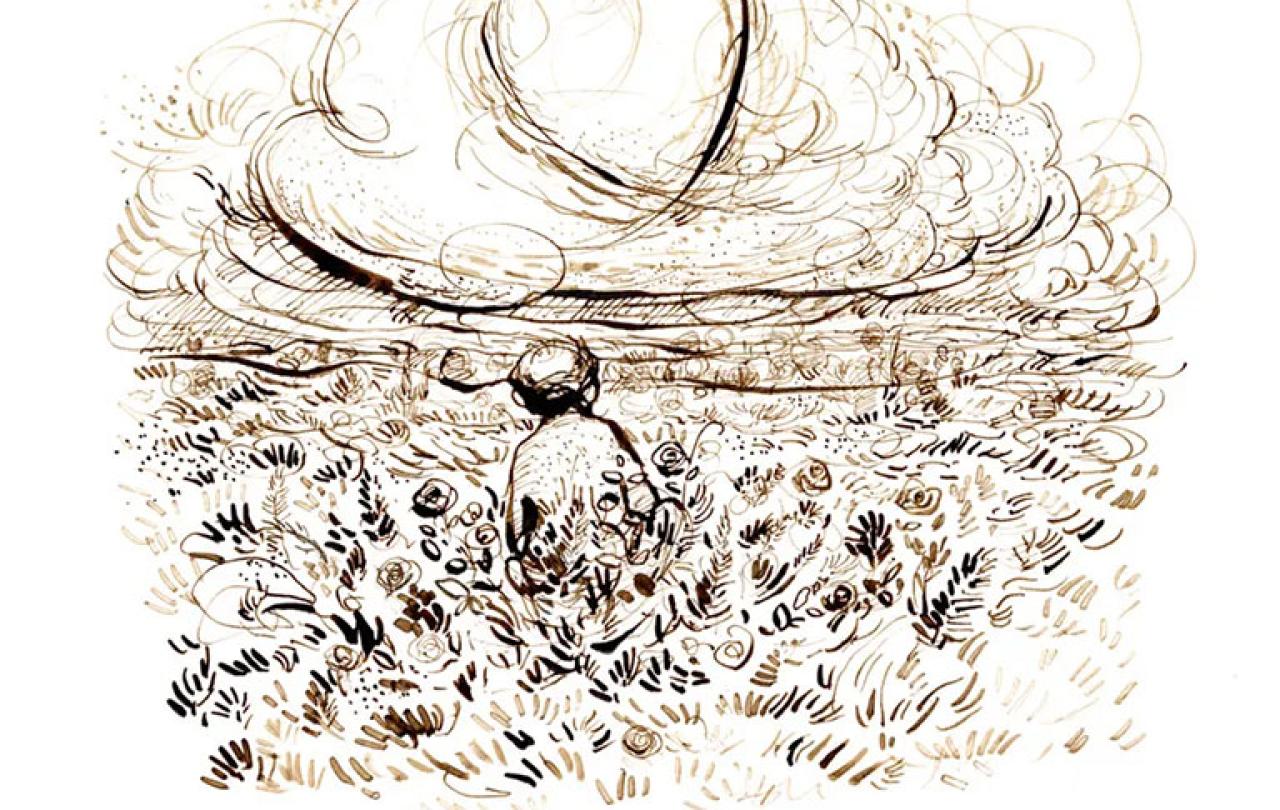
Paul Simon and Charlie Mackesy are the duo we didn’t know we were missing. Well, their collaboration means that we need miss them no longer. In their joint exhibition in Mayfair, Charlie’s artwork is a visual tool with which to ponder Paul Simon’s latest body of work.
Simon and Mackesy
I once read that if you’re looking for the answer to the meaning of life in a pop song, look to Paul Simon. I think whoever wrote that is right. His best-known songs are now decades old, but it doesn’t seem to matter - they’re timeless. And maybe that’s why; he has always written of permanent and universal things.
For example - You may think that he’s crafted an ambiguous tale about two mischievous childhood friends who used to wreak havoc 'down by the schoolyard’, but what he’s actually offered us is a song that gives language to the unexpected and unknown aspects of life. The times that feel like a pathless expanse, the moments that knock us off course, the occasions where we are forced to admit that ‘we don’t know where we’re goin’, but we’re on our way… ’.
And what may, at first glance, appear to be a direct message to an iconic character in The Graduate (Mrs Robinson) or a New York Yankees player (Joe DiMaggio), is actually a song that mourns a loss on behalf of us all. It laments the disappearing of ‘grace, dignity, privacy and fidelity’ in public life – the attributes that ‘our nation turns its lonely eyes to…’
You get the sense that Paul Simon tells the truth, even when he’s spinning a tale.
And then, every now and again, he strips away the fictitious and releases the hymn-like ‘Bridge Over Troubled Water’ or the haunting ‘Sound of Silence’, reminding us that he is concerned with the deepest and truest aspects of existence. His latest body of work, Seven Psalms, is one such offering. But before delving into it, there’s Charlie Mackesy to consider.
Mackesy is an artist who diagnoses our wounds and heals them all at once. As discussed at length in a previous article about his immense impact, his work offers an antidote to our loud and crowded lives. His modern fable - The Boy, the Mole, The Fox, and the Horse - allows us to escape into a fictitious world that feels so much kinder than our own, while also acting as a tool for deep introspection. Charlie puts language and image to our heart’s beautiful yet fragile condition.
And this is undoubtedly why his work has garnered such incredible success. His film is Oscar-winning, his book is best-selling, and his paintings are a fixture of this cultural moment. Charlie’s thoughts adorn therapy waiting rooms, his words are taught in school classrooms, and his images are simply everywhere. It’s hard to think of someone to whom the world is more openly and obviously grateful.
And there we have it: the duo that dreams are made of (it feels appropriate to give Art Garfunkel an honourable mention at this point - what is it with Paul Simon and iconic twosomes?). Now, without further ado, onto their recent collaboration.
Seven Psalms
Seven Psalms is a thirty-three-minute-long body of work. I reference the length, as opposed to the number of tracks, because Simon has released it as one continuous suite of songs; un-skippable and un-shuffle-able. The album makes the most sense as a whole, as a continuation, as a journey. The listener is not in control of how it is listened to, rather, they are tasked with letting it wash over them. They must surrender to Simon’s stream of thought and follow his ponderings to their end. It’s interesting how much un-learning that takes.
I’m no music critic, so I will leave the delineation of the technical details and musical mastery to Rolling Stone, and instead focus my attention on the profoundly spiritual dimensions of this body of work.
And with such, it is hard to know where to begin. There is not one song, in fact, there is not one line, that is not dripping with theological thought. I’m not sure how to sum it up, except to re-iterate Paul’s own understanding of what he has crafted – he has written seven Psalms.
The first song in the interlinked line-up is ‘The Lord’. The chorus of which goes like this:
The Lord is my engineer
The Lord is the earth I ride on
The Lord is the face in the atmosphere
The path that I slip and slide on
These four lines, a re-working of which re-appear as interludes throughout the album, are not pondering the existence of God (which, as Francis Spufford often says, ‘is surely his most boring characteristic’), but the nature of God. This album assumes God’s existence, in fact, it completely hinges upon it. Therefore, it is questions such as - How does he work? How is he present? How do we experience him? How can we perceive him? – that are held within these lyrics.
It seems to me that those are also the questions that Charlie is pondering in the drawings that adorn the walls of Frieze Gallery. Each one is unmistakably a ‘Mackesy’ piece, he is easily identifiable, it is as if he leaves a piece of himself in every frame. What I found particularly interesting about this collection of work, all of which were created in response to him listening to Seven Psalms, is his use of clouds. They are not an uncommon feature in Charlie’s work, but in this context, they caught my attention afresh.
Both the songs and the accompanying sketches create an atmosphere that invites us to seek out sacred answers, to take the time (thirty-three minutes to be precise) to ponder truth and ask the most vulnerable of questions. We see strikingly simple silhouettes of people doing just that in Mackesy’s work, and they’re almost always doing so underneath an imposing canopy of clouds. Clouds that look dark and heavy, clouds that look so light they’re touchable, clouds that are formed in the shape of a heart, even. They vary, but they’re almost always there. I could be wrong, but I don’t think Charlie thinks that we ponder such things alone – his drawings make it seem as though whoever is ‘above’ stoops down to engage in our pondering. If there is a God, he listens in. If Heaven exists, it comes close.
And that, just from his use of clouds. I could write a whole other piece on his use of ‘posture’, and then another on colour. But perhaps you should just go and see for yourself.
Seven Psalms asks the permanent questions, the ones that transcend time, space, and matter. But it doesn’t exist in a vacuum. On the contrary, it is time-stamped for this moment. One of the most striking lines declares that ‘the Covid virus is the Lord’, as is ‘a meal for the poorest of the poor’, ‘an open door to the stranger’ and ‘the ocean rising’. The questions that Paul Simon asks of God directly relate to the questions he then asks about us and this earth we call our home – social justice, ecology, community – his perspectives on such things all seem flow from who the ‘Lord is’. Or perhaps it’s the other way around, the genius is that we’ll never know.
Again, Charlie’s sketches of bustling refugees all walking in the same direction or a mother hitchhiking with her child on what looks to be a bitterly wintry night, lead us to sit with the very same thoughts.
Truthfully, I am all too aware of how inadequate this, or any, review of this collaboration is doomed to be. Paul Simon knew this album transcended words, that’s why he called upon the genius of Charlie Mackesy. So, do yourselves the most profound of favours and spend thirty-three minutes in their company. I say thirty-three minutes, be warned, the impact of their work will reside with you for far longer.
‘Seven Psalms: Illustrated by Charlie Mackesy and Inspired by the Words and Music of Paul Simon’ is a free public exhibition that is running Tuesday-Saturday until the 27th of September 2023, at Frieze Gallery, No.9 Cork Street, Mayfair, London.





